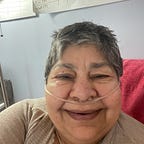Learning to Belong
Healing from Developmental Trauma
What does it mean to belong? Not to another person, not to a family, not to a community but To Belong: to feel a part of one’s surroundings, to the world, to be present in the Universe. Imagine, if you will (which goddess knows I could not until fairly recently) if you felt you did not Belong. When others have looked out at the canyon in my backyard, oohing and aahing over it’s grandeur, I could not comprehend what it meant that I was part of the world I was born into and currently living in. The pristine beauty of nature teeming with wildlife adjoining my home left me feeling only more isolated in my solitary existence.
Early in 2016, soon after my mother’s death, I said to my therapist, “I want to be a real person.” Then I spent months trying to figure out what that entailed. What did it mean to be a real person? Why did I not feel like a real person? How was I defining myself in not being a real person? After almost 6 months of allowing it to sit on my bedside, I began to read the book I had purchased on his recommendation. Healing Developmental Trauma: How Early Trauma Affects Self-Regulation, Self-Image, and the Capacity for Relationship by Aline LaPierre and Laurence Heller. As with all the academic/scholarly books I have read on trauma in the past fifteen years, reading this book left me shaking with recognition and resonance. It took me several weeks to read it, even though I am a fairly speedy and competent reader. This is because I have learned through difficult experience that it is best to allow the mind/body to absorb and process only as much (or as little) new information as they are able to do, and to do it (for the mind/body are one me) at her own speed.
For some survivors of childhood trauma the connection to their mother (traditionally the primary caregiver), their family, then community, then the wider world, is either stymied by the trauma, or no connection forms at all. Because they may feel unwanted or invisible, or the boundaries to their bodies may have been compromised as mine were, they either do not develop (or lose) the ability to engage with the world. When we feel no connection to the tribe of our birth family, it is nearly impossible to feel a part of the human tribe. Not present to our own body, or our body not present to our environment, we are like Pinnochio, drifting through the world not feeling “real” but wanting it more than anything, wanting to be a “real boy”.
Then one day early in spring of 2017, without knowing exactly when the transformation had happened, I walked out into my backyard and saw the mountains beyond my canyon as if for the first time. I saw the residual snow on the tops of the peaks, saw the multitude of green across their expanse, I SAW the mountain. I marveled that the same stardust that made up the mountain, made up the stars, made up the Universe, was present in every moment within my body. I had a right to be born, I had the right to be alive, I had the right to live as I chose. I finally, and for evermore, Belonged.
For more on this Universal connection I invite you to read Living with the Stars: How the Human Body is Connected to the Life Cycles of the Earth, the Planets, and the Stars by Carolus J. Schrijver and Iris Schrijver.
Thank you for reading, and for being a part of this Medium tribe.
©Jk Mansi 2020
